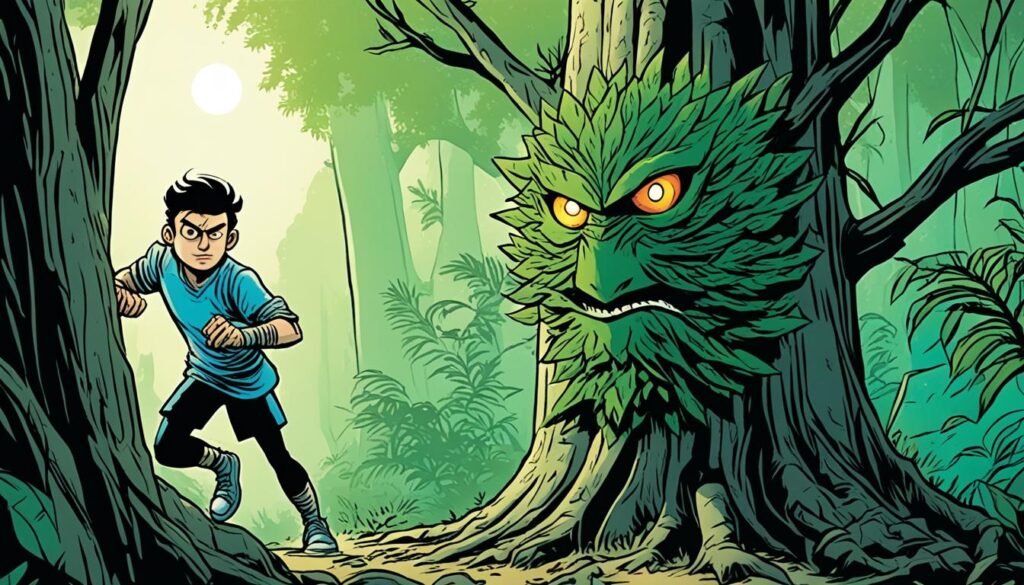In the shadowy corners of the Philippines, where folklore and superstition intertwine, a haunting tale whispers through the night. The tiyanak, a malevolent spirit from the depths of Philippine mythology, is believed to be the cursed soul of an unbaptized child, doomed to roam the earth as a demonic harbinger of darkness.1 This article delves into the dreadful lore surrounding the tiyanak, uncovering its chilling origins, its physical manifestation, and its relentless hunt for unsuspecting prey.1 Rooted in cultural superstitions and cautionary tales, the tiyanak has captured the imagination of many and remains a haunting figure in Philippine mythology.
Key Takeaways
- The tiyanak is a malevolent spirit from Philippine folklore, believed to be the cursed soul of an unbaptized child.
- The tiyanak is known for its chilling origins, horrifying abilities, and relentless hunt for unsuspecting prey.
- Rooted in cultural superstitions and cautionary tales, the tiyanak has captured the imagination of many Filipinos.
- The tiyanak is a haunting figure in Philippine mythology, reflecting the deep-rooted fear and superstition surrounding the concept of the unbaptized, cursed soul.
- This article delves into the dreadful lore and enduring legacy of the tiyanak, a truly terrifying supernatural entity.
The Dreadful Lore of the Tiyanak
According to the lore, the tiyanak is the restless spirit of an infant who died before being baptized, dooming the child’s soul to wander the earth as a malevolent entity.2 This cursed spirit is often described as a small, demonic child with a hideously distorted face and razor-sharp claws.2
Origins of the Forsaken Spirit
Fueled by negative energy, the tiyanak possesses the ability to mimic the cries of a human infant, luring unsuspecting victims to their gruesome demise.2 Its unnatural powers allow it to drain the life force and essence of its prey, leaving behind only lifeless husks.2
Physical Manifestation and Chilling Abilities
The tiyanak is believed to shape-shift into a newborn baby or small child, blending seamlessly into its surroundings to catch its victims off guard.2 This malevolent creature’s vampiric tendencies and association with nature, such as residing in trees or rivers, are also common traits among Filipino ghouls and ghosts.2
The tiyanak’s insatiable hunger and thirst for blood drive it to continue its cycle of predation, making it a truly terrifying and unrelenting force in Philippine folklore.2
Tiyanak: The Unbaptized Demonic Child
The tiyanak is a uniquely Philippine supernatural entity, believed to be the cursed soul of an infant who died without receiving the sacrament of baptism.3 This lack of baptism is seen as dooming the child’s soul to a wretched existence, transforming it into a malevolent, demonic spirit.3 The tiyanak is often depicted as a small, deformed child with a disturbingly inhuman appearance, driven by a ravenous hunger to prey upon the living.3
According to Philippine folklore, the tiyanak is a vampiric creature that typically takes on the form of a newborn baby and attracts victims by crying in the jungle.3 Various versions of the folklore depict the tiyanak with the ability to mimic an infant’s cries in order to lure and attack unsuspecting individuals.3 Historical accounts from the 16th to 18th centuries also mention beliefs in supernatural beings like the tiyanak that obstruct childbirth and prey on children.3
In modern-day Philippines, the tiyanak is believed to be the soul of unbaptized infants seeking revenge or lost souls that wander the earth.3 The tiyanak has been featured in various Philippine movies, TV series, and video games, showcasing its enduring presence in popular culture.3 Additionally, the tiyanak legend has evolved to convey moral and religious messages, emphasizing the importance of baptism and obedience to societal norms.4

The tiyanak is traditionally depicted as a vampiric baby with demonic features, such as red eyes, claws, and sharp teeth.4 However, in some regions, the tiyanak can also take the form of a wild dog or pig, or a monstrous woman and her dead fetus.4 The origin stories of the tiyanak vary, with some sources claiming it is born from unbaptized infants, while others suggest it is created when a baby dies before being named or is buried in a Catholic cemetery.4
Countermeasures against the tiyanak include turning clothes inside out to break its spell, using loud noises to drive it away, and using objects like garlic and the rosary to repel it.3 The tiyanak’s depiction in media, such as movies and books, has also contributed to its transformation and adaptation within Filipino folklore.4
Unhallowed Hunting Grounds
The tiyanak is believed to stalk its victims in a variety of eerie and desolate locations.1 Darkened tiyanak forests, abandoned dwellings, and lonely tiyanak crossroads are all said to be favored hunting grounds for the cursed spirit.1 These isolated, ominous settings provide the tiyanak with the perfect opportunity to lure the unsuspecting into its deadly trap.1 The tiyanak’s ability to blend seamlessly into its surroundings, coupled with the ominous atmosphere of its chosen tiyanak hunting grounds, make it a truly formidable and terrifying predator.
Eerie Forests and Abandoned Dwellings
The darkened tiyanak forests are said to be a prime hunting ground for the cursed spirit, providing it with ample cover and the perfect setting to lure in unsuspecting victims.1 Similarly, abandoned tiyanak dwellings are believed to be haunt by the malevolent entity, its depraved presence lingering within the dilapidated structures.
Desolate Crossroads and Lonely Paths
The tiyanak is also said to lurk along desolate tiyanak crossroads and lonely paths, where the cursed spirit can blend seamlessly into the shadows and ambush its prey.1 These isolated, ominous settings offer the tiyanak the perfect opportunity to exploit the vulnerability of unsuspecting passersby, luring them into its deadly trap.
Luring the Unsuspecting Prey
The tiyanak is known for its cunning and deceptive tactics in ensnaring its victims. Utilizing its ability to perfectly mimic the cries of a human infant5, the tiyanak lures in unsuspecting passersby, especially those with a strong parental instinct5. Drawn in by the plaintive wails, victims approach the source of the sound, only to come face-to-face with the demonic child6. The tiyanak then viciously attacks, exploiting the victim’s hesitation and caring nature to secure its gruesome feast5.
Mimicking Cries of an Infant
Tiyanaks are known to communicate through telepathy and use sound mimicry to lure unsuspecting prey5. Their ability to perfectly replicate the cries of a human infant is a key part of their predatory strategy, drawing in victims with the plaintive wails5.
Exploiting Parental Instincts
Tiyanaks specifically target individuals with strong parental instincts, knowing that the innate desire to care for a child will lead them to approach the source of the infant’s cries5. This exploitation of the victim’s caring nature is a crucial element of the tiyanak’s hunting tactics5.

The Tiyanak’s Unholy Feast
Once the tiyanak has lured in its prey, it proceeds to unleash its unholy power. Using its supernatural abilities, the tiyanak drains the life force3 and very essence3 of its victim, leaving behind nothing but a lifeless husk. This gruesome act is believed to sustain the tiyanak’s own dark existence, fueling it with the stolen vitality of the innocent.3 The tiyanak’s insatiable hunger drives it to continue this cycle of tiyanak feast, making it a truly terrifying and unrelenting force in Philippine folklore.3
Draining Life Force and Essence
The tiyanak is primarily depicted as a newborn baby, with the ability to mimic the cries of an infant convincingly.7 In some legends, the Tiyanak transforms into a monstrous form with sharp claws, fangs, and glowing eyes to attack its victims.7 This shape-shifting capability allows it to lure victims by appearing as an innocent baby before revealing its true tiyanak essence drain monstrous form.7 The tiyanak’s insatiable hunger is believed to drive it to tiyanak life force drain continue this cycle of predation, making it a truly terrifying and unrelenting force in Philippine mythology.37
Protective Rituals and Folklore
To protect against the tiyanak’s malevolent influence, Philippine folklore describes various8 rituals and remedies. These include the use of traditional amulets, blessed objects, and specific incantations designed to ward off the cursed spirit.8 Certain plants and herbs are also believed to have the power to repel the tiyanak, while the performance of cleansing ceremonies may help to cleanse an area of the tiyanak’s presence.8 These time-honored traditions reflect the deep-rooted fear and superstition surrounding the tiyanak in Philippine culture.
Warding Off the Cursed Spirit
Filipinos have been practicing8 rituals for years to drive away monsters or evil spirits. The tiyanak, described as a baby devil in disguise seeking revenge,8 is believed to be one such malevolent entity that can be warded off through various protective measures.8 Wearing a rosary and garlic are mentioned as8 protective measures against the tiyanak, reflecting the intertwining of Christian and indigenous beliefs in Philippine folklore.
Traditional Remedies and Amulets
Elders believe that the unborn children, which the tiyanak represents, were taken by the devil and sent back as monsters to sow terror among those responsible for their death.8 To counter this cursed spirit, traditional remedies and amulets play a significant role in Philippine8 folklore.9 The traditional belief systems and indigenous religions of the Philippines, known as Anito and Anitism, have long incorporated these protective measures against supernatural threats like the tiyanak.9

The tiyanak is said to mimic a baby crying in the woods to lure victims,8 and encounters with this malevolent entity are common in rural areas,8 reflecting the folklore’s deep roots in the Philippine countryside.9 The text mentions the tiyanak transforming from a cute baby into a monstrous form with sharp claws, big eyes, shrunk skin, and an old appearance,8 further emphasizing the need for effective protective rituals and amulets to safeguard against this cursed spirit.
| Traditional Remedies | Protective Amulets |
|---|---|
| Cleansing ceremonies | Blessed objects |
| Herbal concoctions | Talisman |
| Incantations | Rosary |
| Purification rituals | Garlic |
Tiyanak in Philippine Mythology
The tiyanak holds a significant place in Philippine mythology, serving as a cautionary tale and a reflection of cultural beliefs.3 The story of the tiyanak is often used to warn children about the consequences of misbehavior or disrespect, with the demonic child spirit serving as a terrifying example of what can happen to those who stray from the righteous path.3 The tiyanak’s enduring presence in Philippine folklore also speaks to the deep-seated fear and superstition that surrounds the concept of the unbaptized, cursed soul, and the need to uphold important cultural and religious traditions.3
Cultural Significance and Cautionary Tales
Across different regions in the Philippines, such as Mindanao, Central Luzon, and Batangas, the tiyanak is depicted with unique traits and abilities, reflecting the diverse cultural beliefs and folktales surrounding this mythological creature.3 The tiyanak myth was introduced to Catholicism during Spanish colonization and has evolved to include modern beliefs regarding aborted fetuses seeking revenge for being deprived of life.3
The tiyanak is a popular subject in Philippine movies and TV series, such as “Tianak” (1953), “Tiyanak” (1988), and in episodes of TV shows like “Juan dela Cruz” and anime series like “Trese”.3 The tiyanak is often used as a cautionary tale, warning about the dangers of disobedience and the consequences of disrespecting cultural and religious traditions.3
The enduring presence of the tiyanak in Philippine folklore reflects the deep-seated cultural significance and cautionary tales associated with this mythological creature.3 The tiyanak’s ability to mimic an infant and lure victims with its cries, as well as its varied forms and origins, have captivated the imagination of the Filipino people for generations.3
Haunting Encounters and Eyewitness Accounts
Throughout Philippine history, there have been numerous reports of chilling encounters with the tiyanak.10 Eyewitness accounts describe the sudden appearance of a small, deformed child with a distorted, inhuman face, often accompanied by the sound of a baby’s cries.10 In some cases, victims claim to have been lured into isolated areas by the tiyanak’s mimicry, only to narrowly escape the creature’s deadly grasp.10 These haunting accounts have further solidified the tiyanak’s place in Philippine folklore, fueling the ongoing fear and fascination with this supernatural entity.
According to Global Indonesian Voices, ghost stories in Indonesia are popular and have outlived their original usefulness, with some people seeing them as harmless fun while others take them more seriously.10 Rumors and gossip also play a significant role in spreading beliefs in ghosts in Jakarta, with incidents such as a ghostly train journey and haunted locations attracting attention.10
These tiyanak encounters and eyewitness accounts have further solidified the creature’s place in Philippine folklore, fueling the ongoing tiyanak sightings and the deep-rooted fear and fascination with this supernatural entity.

The Tiyanak in Popular Media
The tiyanak, a malevolent spirit from Philippine folklore, has made a lasting impact on various forms of popular media. From the pages of literary works to the silver screen, this iconic supernatural entity has captured the imagination of audiences both within the Philippines and around the world.4
Literary Works and Urban Legends
In the realm of literature, the tiyanak has been the subject of numerous short stories, novels, and urban legends. These chilling tales often feature the tiyanak as a terrifying antagonist, preying upon the unsuspecting and exploiting their deepest fears.4 The tiyanak’s eerie origins, demonic appearance, and predatory nature have made it a captivating figure in Philippine supernatural fiction, further solidifying its status as a cultural icon.
Film and Television Depictions
Beyond the written word, the tiyanak has also found a home in visual media, with both horror films and television shows depicting the creature’s unsettling presence. These cinematic and televised portrayals have allowed audiences to witness the tiyanak’s chilling abilities, from its skill in mimicking the cries of a human infant to its relentless hunger for the life force of its victims. Such vivid representations have helped to cement the tiyanak’s place as an enduring and iconic figure in Philippine supernatural folklore.
Through its diverse appearances in popular media, the tiyanak has continued to captivate and terrify audiences, solidifying its status as a truly haunting and unforgettable entity in Philippine mythology.4 The tiyanak’s enduring legacy in literature, film, and television serves as a testament to the power of this malevolent spirit to capture the collective imagination of the Filipino people.
Psychological Impact and Societal Influence
The tiyanak’s place in Philippine culture extends beyond the realm of folklore, influencing the psychological and societal landscape. Filipinos have a persistent belief in the existence of the aswang, with their cultish devotion to this folklore creature remaining strong.11 The fear and superstition surrounding the tiyanak have had a profound impact on the collective psyche of the Filipino people, shaping behaviors, beliefs, and even parenting practices.
The tiyanak’s role as a cautionary tale serves to reinforce cultural values and traditions, while also reflecting deeper societal anxieties about the vulnerabilities of childhood and the consequences of spiritual transgressions. Pre-colonial propaganda played a significant role in shaping beliefs, with the spread of propaganda by Spanish friars upon their arrival in the Philippines.11 Additionally, there is a societal influence on the belief in aswang due to Filipinos’ strong oral tradition and respect for elders’ authority, often using stories about aswang to caution children from wandering at night.11
The enduring presence of the tiyanak in Philippine consciousness speaks to its lasting psychological and societal influence. Women, particularly strong ones like babaylans (female spiritual leaders), were targeted as being aswang by Catholic authorities to suppress political dissent and promote modern medicine.11

Ongoing Research and Investigations
The tiyanak12 continues to captivate the interest of researchers and folklore experts, who delve into the intricate details of this supernatural entity. Paranormal investigators have conducted studies and field research, attempting to uncover the origins and nature of the tiyanak,12 while folklorists and anthropologists have explored the cultural significance and historical context of this iconic figure.12 Through these ongoing efforts, a deeper understanding of the tiyanak’s place in Philippine mythology and its enduring impact on the collective psyche is being steadily revealed.12
Paranormal Studies and Folklore Experts
Researchers delving into the tiyanak research have utilized a multidisciplinary approach, drawing from the expertise of paranormal investigators, folklorists, and cultural anthropologists.12 These experts have sought to unravel the mysterious origins of the tiyanak, examining tiyanak paranormal studies and exploring the tiyanak folklore that has been passed down through generations.12 By piecing together the cultural, historical, and supernatural elements surrounding this iconic figure, they aim to provide a comprehensive understanding of the tiyanak’s enduring legacy in Philippine mythology.12
Separating Fact from Fiction
As with any folklore or supernatural phenomenon, it is important to distinguish between fact and fiction when it comes to the tiyanak. By examining credible sources, such as academic studies, historical records, and first-hand accounts, researchers and skeptics alike can work to separate the verifiable aspects of the tiyanak from the more fantastical elements of the legend.13
Examining Credible Sources
While the tiyanak has captured the imagination of many through its chilling depictions in popular media, it is crucial to look beyond sensationalized accounts and explore the rigorous research conducted by experts in the field. Scholarly studies delving into the origins, cultural significance, and reported sightings of the tiyanak can provide a more nuanced understanding of this supernatural entity.13
Rational Explanations and Skepticism
Alongside the extensive folklore surrounding the tiyanak, some scholars have proposed rational explanations for its origins and manifestations, grounding the creature in natural phenomena or psychological factors. This critical analysis helps to provide a more balanced perspective, acknowledging the enduring power of the tiyanak in Philippine culture while also exploring alternative interpretations.13
| Fact | Fiction |
|---|---|
| The tiyanak is a well-documented figure in Philippine folklore, with numerous historical accounts and cultural traditions surrounding it.13 | The tiyanak is a purely supernatural entity, with no basis in reality or natural explanations.13 |
| Credible sources, such as academic studies and first-hand accounts, can help separate the verifiable aspects of the tiyanak from the more fantastical elements.13 | The tiyanak is a product of pure imagination, without any grounding in real-world phenomena or psychological factors.13 |
| Some scholars have proposed rational explanations for the tiyanak‘s origins and manifestations, offering a more nuanced understanding of this iconic figure.13 | The tiyanak is a purely supernatural entity, with no room for alternative interpretations or skeptical analysis.13 |

Conclusion
The tiyanak, with its chilling origins, horrifying abilities, and enduring presence in Philippine folklore, remains a captivating and deeply unsettling figure. This malevolent spirit, believed to be the cursed soul of an unbaptized child, continues to haunt the collective imagination of the Filipino people, serving as a cautionary tale and a reflection of cultural beliefs and anxieties.14
Through ongoing research, investigation, and critical analysis, the intricate details and societal impact of the tiyanak are being steadily revealed, providing a deeper understanding of this iconic supernatural entity.14 Whether viewed through the lens of folklore, psychology, or rational skepticism, the tiyanak’s enduring legacy in Philippine mythology is undeniable, cementing its status as a truly haunting and unforgettable phenomenon.14
As researchers continue to explore the cross-cultural intersections of Southeast Asian folk literature, the tiyanak remains a captivating subject, offering insights into the cultural beliefs, fears, and superstitions that have shaped the Philippine collective consciousness.14 The tiyanak’s enduring legacy serves as a testament to the power of folklore to reflect and perpetuate the human experience, leaving an indelible mark on the nation’s mythology and popular culture.
FAQ
What is the tiyanak?
What is the tiyanak’s physical appearance?
How does the tiyanak hunt its prey?
What happens when the tiyanak catches its prey?
How can one protect against the tiyanak?
What is the cultural significance of the tiyanak in the Philippines?
What is the impact of the tiyanak in Philippine popular media?
How do researchers and experts approach the study of the tiyanak?
Is there a distinction between fact and fiction when it comes to the tiyanak?
Source Links
- https://tvtropes.org/pmwiki/pmwiki.php/Characters/PathfinderUndead
- https://janinelim.substack.com/p/i-aint-afraid-of-no-ghost
- https://en.wikipedia.org/wiki/Tiyanak
- https://www.victormanibo.com/blog/e1dx8xmxq52ea7yxqyaeg424iwr86t
- https://pathfinder.d20srd.org/bestiary5/tiyanak.html
- https://aswayofwords.wordpress.com/2014/11/01/philippines-monsterology-101/
- https://mythlok.com/tiyanak/
- https://www.mangkukulam.com/folklore/355/Tiyanak
- https://en.wikipedia.org/wiki/Philippine_mythology
- https://factsanddetails.com/indonesia/History_and_Religion/sub6_1f/entry-3984.html
- https://www.gmanetwork.com/news/lifestyle/artandculture/267856/ijuander-why-do-filipinos-still-believe-in-aswang/story/
- https://en.wikipedia.org/wiki/Anito
- http://taliesinttlg.blogspot.com/2017/10/tiyanak-review.html
- https://papers.iafor.org/wp-content/uploads/papers/acas2013/ACAS2013_0102.pdf

